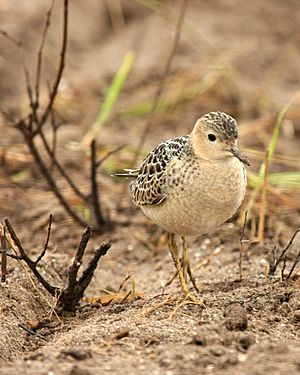Buff-breasted sandpiper facts for kids
Quick facts for kids Buff-breasted sandpiper |
|
|---|---|
 |
|
| Conservation status | |
| Scientific classification | |
| Synonyms | |
|
Tryngites subruficollis |
The buff-breasted sandpiper (Calidris subruficollis) is a small shorebird. It gets its name from its "buff" or yellowish-brown chest. The scientific name subruficollis comes from Latin words meaning "somewhat reddish" and "neck." This describes its reddish-brown neck. It is a type of sandpiper, a bird often found near water.
Contents
What Does the Buff-Breasted Sandpiper Look Like?
This sandpiper has a brown back. Its face and belly are buff-colored, which is a yellowish-brown. It has a short beak and yellow legs. Male buff-breasted sandpipers are usually larger than females. Young birds look similar to the adults. However, their lower belly might be a bit paler.
Where Do Buff-Breasted Sandpipers Live?
Buff-breasted sandpipers breed, or have their babies, in the wide-open arctic tundra of North America. This includes places like Alaska and Canada. They are amazing long-distance migrants. They spend the non-breeding season mainly in South America, especially Argentina.
These birds usually travel through central North America. They are not very common along the coasts. Sometimes, they wander to western Europe. They are seen regularly in Great Britain and Ireland. Small groups have even appeared there. Only the pectoral sandpiper is a more common American shorebird visitor to Europe.
Nesting and Habits
This species builds its nests on the ground. They nest as far north as Canada, including Alaska. Each nest usually has four eggs. The male bird performs a special display. He raises his wings to show their white undersides. He does this even during migration, sometimes when no other buff-breasted sandpipers are nearby.
Outside the breeding season, these birds prefer short-grass habitats. You might find them on airfields or golf courses. They usually avoid areas right next to water.
Buff-breasted sandpipers find their food by sight. They mainly eat insects and other small invertebrates. They are known to eat Bombus polaris, a type of bumblebee found in the Arctic Circle. They might eat the bees themselves or feed them to their young. These birds are often very calm and not easily scared.
Scientists think that buff-breasted sandpipers might have hybridized with other sandpipers. This means they might have had babies with birds like the White-rumped sandpiper or Baird's sandpiper.
Sightings in Other Places
Far Away Journeys
This species has been seen in South Asia at least three times. It is thought that strong winds might have blown these birds off course. Instead of flying to Argentina, they ended up in South Asia. For example, in November 2011, a buff-breasted sandpiper was seen near Kannur, Kerala in South India. It was photographed by Dr. Jayan Thomas.
The buff-breasted sandpiper has also been recorded in Australia at least eight times. In 1978, a bird was seen in Sri Lanka. After that, very few sightings were recorded there. In 2001, a single bird was also seen in Marievale, South Africa.
See also
 In Spanish: Correlimos canelo para niños
In Spanish: Correlimos canelo para niños
Tryngites subruficollis in Field Guide: Birds of the World on Flickr species name is missing



